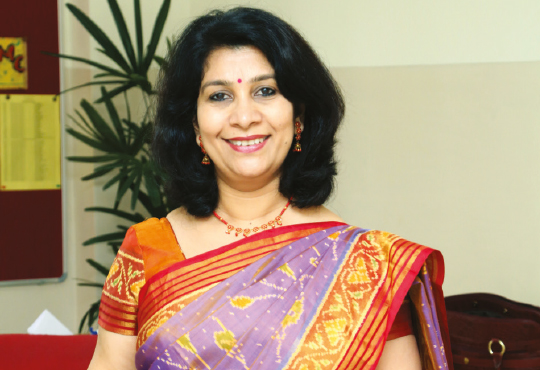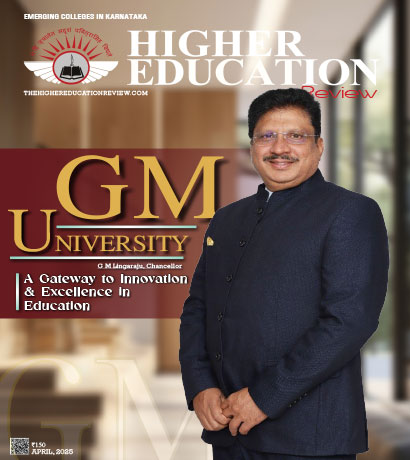Nurturing Student Creativity!

Shefali Tyagi, Principal, National Public School
In a knowledge economy where rote tasks can be completed by machines and almost all information is available with one click, students need to be ready to learn independently, adapt constantly, innovate regularly and solve creatively in every sphere of life. Creativity stems from imagination and keeping the fire of imagination alive is imperative.
Creativity and imagination aren't mystical gifts bestowed to just a few blessed individuals, it's a skill that you can hone and develop. Creativity is a response, an attitude that enhances the thinking process. Education and creativity may seem like an oxymoron due to a seemingly rigid system, yet it is possible to unleash creativity despite the rigidity of the structure. Thinking differently in a digital environment to create useful solutions to challenges, is what students require to be trained for. It is interesting to note that every person is born with this ingenuity, the ability to think anew and give everything a new perspective with divergent thinking. In today's technology-driven era inventiveness in the workforce has become an essential requirement to sustain in the long run and for that, an innovative thinking model is needed, hence the effect of technologies on students' creativity must be considered carefully. According to Collard, "Creative skills aren't just about good ideas, they are about having the skills to make good ideas happen."
"Creativity and imagination aren't mystical gifts bestowed to just a few blessed individuals, it's a skill that you can hone and develop"
We must think of creativity as a skill, much like resourcefulness and inventiveness, it is less a trait and more a proficiency that can be taught. If we see it this way, our role as educators becomes to find ways to encourage its use and break it down into smaller skill sets. Imagination and creativity are the traits that fuel the future, and both serve to inspire students, hence, they must be integrated into every part of learning. These are some tried and tested tools:
1. Allow free flow of creativity by designating and designing a space in the classroom for exploration of creativity such as - a thinking chair, synergy region, a drama stage, a drawing table, or ideation corner. You might be surprised by what they come up with.
2. Begin creativity in the classroom and modeling it in teaching by using mind maps, concept maps, spider diagrams or inquiry-based learning, which are a flexible and powerful tool for representing information and nurturing creative and critical thinking.
3. Create a classroom that values recognizes and celebrates learners' creative and innovative contributions. It can be done by designing bulletin boards or brainstorming different ways of solving a problem in a real-world scenario.
4. Design assignments that consider not just convergent thinking, where we look at one concrete solution, but also divergent thinking models by looking at the multiplicity of thoughts. This will help a teacher to see how a learner can use different ways to approach a problem.
5. Encourage sensible risk-taking, allow for flexibility and create norms that promote creativity. Sir Ken Robinson said it best when he said, "If you're not prepared to be wrong, you'll never come up with anything original." The classroom environment must be a place where students feel safe to share novel ideas and the teachers openly try something new in their lessons.
Teachers who can model creative ways of thinking and playfully engage with the content will be able to unleash the creativity that lies dormant in the student.
Mathematics ironically is believed to have one conclusive right answer, but it involves solving problems, including those which are non-routine, and that, of course, involves thinking creatively. In 2004, a young mathematician, Manjul Bhargava was awarded Field Medal in mathematics, an equivalent of the Nobel Prize, for his significant contributions to the field. His achievement was to simplify a very complicated mathematical 'proof' from the 18th century into a few lines. He was inspired by Rubik's Cube and imagined that the numbers that he was working on were applied to the corners of the Rubik's Cube. It was his process of thinking in his own unique way that leads to this breakthrough.
Have you ever asked a child to describe her painting or drawing? The description will transport you to a world of imagination that these little children are blessed with. We are all born with a creative instinct and all people have creative potential. Young children naturally engage in play a state when the imagination is used to 'try out' situations and possibilities. A cardboard box becomes a car, grass becomes food, twigs become cutlery, a toy comes alive. As children mature their creativity gets stifled as an unintended consequence of other pressures. Students can become fearful of making mistakes if they only receive recognition for giving an answer. As they grow the norms and expectations take over creativity.
Today, more than ever before, education must enable children to think differently because we are all a part of the global platform. We must all be able to think creatively, manage change, and solve complex open-ended problems. It, therefore, goes without saying that training students to be open to tackling problems with novel solutions is the need of the day.
Shefali Tyagi, Principal
Shefali Tyagi completed her education in Masters of Business Management from Dayalbagh Educational Institute. She did her Bachelor of Commerce degree from Sadhu Vaswani Mission's St Mira College for girls arts and commerce in Pune and she also has a Bachelor of education degree from University Of Jammu.
Creativity and imagination aren't mystical gifts bestowed to just a few blessed individuals, it's a skill that you can hone and develop. Creativity is a response, an attitude that enhances the thinking process. Education and creativity may seem like an oxymoron due to a seemingly rigid system, yet it is possible to unleash creativity despite the rigidity of the structure. Thinking differently in a digital environment to create useful solutions to challenges, is what students require to be trained for. It is interesting to note that every person is born with this ingenuity, the ability to think anew and give everything a new perspective with divergent thinking. In today's technology-driven era inventiveness in the workforce has become an essential requirement to sustain in the long run and for that, an innovative thinking model is needed, hence the effect of technologies on students' creativity must be considered carefully. According to Collard, "Creative skills aren't just about good ideas, they are about having the skills to make good ideas happen."
"Creativity and imagination aren't mystical gifts bestowed to just a few blessed individuals, it's a skill that you can hone and develop"
We must think of creativity as a skill, much like resourcefulness and inventiveness, it is less a trait and more a proficiency that can be taught. If we see it this way, our role as educators becomes to find ways to encourage its use and break it down into smaller skill sets. Imagination and creativity are the traits that fuel the future, and both serve to inspire students, hence, they must be integrated into every part of learning. These are some tried and tested tools:
1. Allow free flow of creativity by designating and designing a space in the classroom for exploration of creativity such as - a thinking chair, synergy region, a drama stage, a drawing table, or ideation corner. You might be surprised by what they come up with.
2. Begin creativity in the classroom and modeling it in teaching by using mind maps, concept maps, spider diagrams or inquiry-based learning, which are a flexible and powerful tool for representing information and nurturing creative and critical thinking.
3. Create a classroom that values recognizes and celebrates learners' creative and innovative contributions. It can be done by designing bulletin boards or brainstorming different ways of solving a problem in a real-world scenario.
4. Design assignments that consider not just convergent thinking, where we look at one concrete solution, but also divergent thinking models by looking at the multiplicity of thoughts. This will help a teacher to see how a learner can use different ways to approach a problem.
5. Encourage sensible risk-taking, allow for flexibility and create norms that promote creativity. Sir Ken Robinson said it best when he said, "If you're not prepared to be wrong, you'll never come up with anything original." The classroom environment must be a place where students feel safe to share novel ideas and the teachers openly try something new in their lessons.
Teachers who can model creative ways of thinking and playfully engage with the content will be able to unleash the creativity that lies dormant in the student.
Mathematics ironically is believed to have one conclusive right answer, but it involves solving problems, including those which are non-routine, and that, of course, involves thinking creatively. In 2004, a young mathematician, Manjul Bhargava was awarded Field Medal in mathematics, an equivalent of the Nobel Prize, for his significant contributions to the field. His achievement was to simplify a very complicated mathematical 'proof' from the 18th century into a few lines. He was inspired by Rubik's Cube and imagined that the numbers that he was working on were applied to the corners of the Rubik's Cube. It was his process of thinking in his own unique way that leads to this breakthrough.
Have you ever asked a child to describe her painting or drawing? The description will transport you to a world of imagination that these little children are blessed with. We are all born with a creative instinct and all people have creative potential. Young children naturally engage in play a state when the imagination is used to 'try out' situations and possibilities. A cardboard box becomes a car, grass becomes food, twigs become cutlery, a toy comes alive. As children mature their creativity gets stifled as an unintended consequence of other pressures. Students can become fearful of making mistakes if they only receive recognition for giving an answer. As they grow the norms and expectations take over creativity.
Today, more than ever before, education must enable children to think differently because we are all a part of the global platform. We must all be able to think creatively, manage change, and solve complex open-ended problems. It, therefore, goes without saying that training students to be open to tackling problems with novel solutions is the need of the day.
Shefali Tyagi, Principal
Shefali Tyagi completed her education in Masters of Business Management from Dayalbagh Educational Institute. She did her Bachelor of Commerce degree from Sadhu Vaswani Mission's St Mira College for girls arts and commerce in Pune and she also has a Bachelor of education degree from University Of Jammu.

